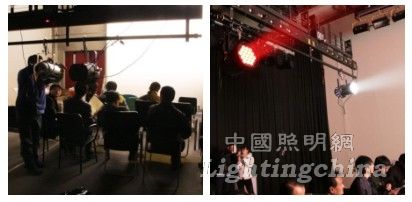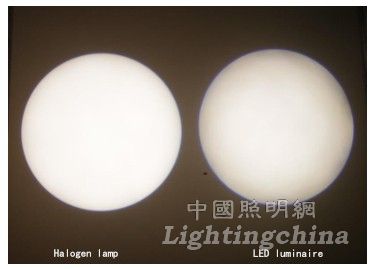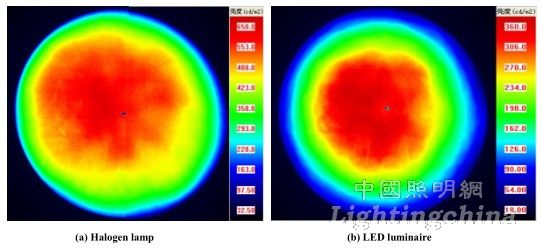1 Introduction
Stage lighting as an art lighting, the brightness, light effect, color temperature, color rendering, dimming, light control and flash characteristics of the light source must meet certain requirements. Traditional stage lighting usually uses a tungsten halogen lamp as a light source, which consumes high energy and has low luminous efficiency. 95% of the electric energy consumed is converted into heat, which causes the stage actor to feel fatigue in a long time of high temperature and affect the performance. LED light source is gradually accepted by stage lighting designers with its advantages of energy saving, bright color, dimming, etc. [1, 2], LED lamps enter a new development period of stage lighting. However, the LED stage lighting is a new type of light source. The time to market is short, and there is no set standard. The market is still difficult to standardize. There are great differences in the performance of lamps on the market, mixed fish, and what are the performance requirements of stage lamps [3, 4]. How to judge the pros and cons of stage lamps is a brand new job. The application effect of the luminaire and the subjective visual perception of the audience are important factors in evaluating the pros and cons of the luminaire. Subjective assessment is a link that cannot be ignored in the acceptance of the stage luminaire. This paper starts from the perspective of actual lighting acceptance, and elaborates on the evaluation ideas and methods combining objective detection and subjective evaluation.
2 Evaluation work content and ideas
The evaluation of the luminaire includes both objective and subjective content. First, we decompose and refine the luminaire evaluation task, as shown in Figure 1. Objectives include safety, optics, electricity, temperature and noise, mainly through instruments; subjective assessment items include spot quality (edge ​​morphology, uniformity), dimming performance, color rendering, through the construction of experimental scenarios, design questionnaires And the instrument assists in detecting brightness or illuminance data to complete.
The evaluation object is a high-power white LED imaging lamp, and the tungsten halogen lamp with corresponding luminous flux and beam angle is selected as the reference for replacing the lamp, as shown in Table 1.

Figure 1 Assessment work classification and segmentation
Table 1 Basic information of LED white light evaluation lamps

2.1 Scene construction
The subjective evaluation experiment was carried out in a dark room. The two lamps were set up as separate compartments, and the fixtures were placed according to the actual use scene, as shown in Figure 2. By adjusting the light output of the two lamps, the average illumination in the effective spot on both screens is guaranteed to be 200Lx.

Figure 2 Subjective assessment scenario
2.2 Questionnaire design
The questionnaire design consists of three parts: spot quality, dimming performance and color rendering. In the evaluation of spot quality and dimming performance, the scale is set to 5 levels, from -2 to +2, where -2 corresponds to poor, 0 corresponds to general, and +2 corresponds well. In the color rendering evaluation, the questionnaire was designed as two color preference and color difference. The first item is an assessment of color preference, including tests for fruits, flowers, and skin color. The performance is: -2 corresponds to very dislike, 0 corresponds to general, and +2 corresponds to very much. The second term is the evaluation of chromatic aberration. The representation is as follows: VL (Very Large) corresponds to very large, L (Large) corresponds to large, M (Medium) corresponds to medium, S (Small) corresponds to small, and VS Very Small) corresponds to very small.
Twelve subjects were selected, including 6 males and 6 females, aged between 25 and 35. All of them had normal or corrected visual acuity, and there were no other eye diseases such as color blindness. Each subject participated in all experimental tasks under all conditions. .
3 subjective assessment principle method
3.1 Spot quality
As far as the quality of the spot is concerned, the criteria for judging the merits of different types of lamps are not the same. For example, a high-power astigmatism lamp for illuminating the skylight, such as a daylight lamp or a floor lamp, requires a large illumination area and a uniform light spot between the lamps; a spotlight, an imaging lamp, and the like, and a concentrating lamp for modeling illumination, which cannot have flowers. Spot phenomenon, the beam of this type of lamp is concentrated, the light of the edge is small, and the spot is clearly defined. Considering the finiteness of the human eye to the change of brightness, the subjective evaluation uses the imaging luminance meter to objectively detect the brightness.
3.2 Dimming performance
Since the LED light source responds extremely fast, reaching the nanosecond level, the brightness changes from one order of magnitude to another, which is instantaneous, and reasonable dimming has a significant impact on the overall performance of the luminaire. PWM dimming is currently considered to be the most promising LED dimming technology. The choice of dimming frequency is directly related to the presence or absence of stroboscopic phenomenon, especially in the initial stage of lighting. In this evaluation, it is mainly observed whether the bright change of the spot during the dimming process is linearly output and whether there is flicker.
In addition, due to the voltage change during the dimming process, the tungsten halogen lamp will change the color temperature of the light source, the voltage is high, the color temperature of the light source is also high, the voltage is low, and the color temperature of the light source is also low. However, PWM dimming ensures that the LED always operates between full-scale current and zero. The source does not produce any chromatographic offset, which ensures that the color temperature of the luminaire is constant during dimming. Collect color temperature data in different states and provide reference for objective data for subjective assessment.
3.3 Color rendering
The color rendering of white light fixtures is an important task in subjective assessment. In the past few decades, the Color Rendering Index (CRI) developed by the International Institute of Illumination (CIE) is the most commonly used index for evaluating color quality. The original intent was to evaluate the color rendering performance of fluorescent lamps. Eight medium to low saturation color samples were chosen to represent the average hue of the objects. These color samples were compared between the test source and the reference source (sunlight and incandescent). In the experiment, the value of the CRI is obtained by calculating the arithmetic mean of the deviations of the eight color samples. CIE specifies the definition of color rendering as the effect of a light source on the hue of an object compared to the hue under the reference illuminator. The index used for evaluation is the color rendering index [5-6].
Based on the special spectral distribution of the new LED light source, the problems in the CRI calculation method are also increasingly prominent [5]. Mainly reflected in: high CRI values ​​can not guarantee a good saturation color; for light sources that can enhance color saturation, CRI values ​​are instead "punished"; when the light source achieves one or a few colors When the deviation occurs, the CRI calculation method does not respond well. In addition, CIE clearly stated in the 2007 technical report that the current color rendering index CRI cannot effectively reflect the color rendering of white light illumination sources including white LEDs [7].
So far, a unified light source color quality evaluation system has not been formed in the world, but one thing is certain: the human visual experience is the decisive factor of the color quality of the light source. The CQS (Color Quality Scale), a new evaluation system developed by the National Institute of Standards and Technology (NIST), attempts to find an evaluation method that can measure the color rendering of all light sources. CQS [8] has four points of improvement compared to CRI: that is, 15 high-saturation color samples are selected, and the color gamut is enlarged (approximate to the color of all objects); the calculation formula is changed to the root mean square formula, for any The small deviation of color, CQS value can be reflected; CIELAB coordinate system is used to replace the original CIE-uv coordinate system; considering the factors of color reduction, hue discrimination and color preference. Although the CQS evaluation method still has certain defects, compared with CRI, the former has some improvement on the evaluation of LED light source, and considering the human visual experience is another major progress.
Therefore, in the research of this subject, we draw on the research idea of ​​color quality number (CQS) [9-10], design subjective evaluation to observe the color preference of the LED white light fixture and the corresponding tungsten halogen lamp. Two characteristics of color difference.
The color difference experiment uses the MCC color card, which is a standard method specified by the CIE to compare the color difference between the light source to be tested and the reference source. Two sets of color cards were placed under the two lamps to observe, and the tungsten halogen lamp was used as the reference light source. The subjects observed 24 pairs of color samples in the color card illuminated by the LED lamps, and evaluated the color difference of each pair.
4 Results analysis and data processing
4.1 Spot quality
Figure 3 is a photo of the comparison between the LED luminaire and the corresponding halogen tungsten luminaire. The edge of the LED illuminator is clear and has no streaks, which can basically achieve the effect of the tungsten halogen lamp. Figure 4 shows the brightness distribution of the two lamps. Compared with the 750W halogen lamp, the 200W LED lamp can achieve higher brightness value when the same power output, and the LED lamp can replace the halogen lamp to achieve energy saving effect. .

Figure 3: Spot contrast between LED and tungsten halogen lamps

Figure 4: Brightness distribution of LED and tungsten halogen lamps